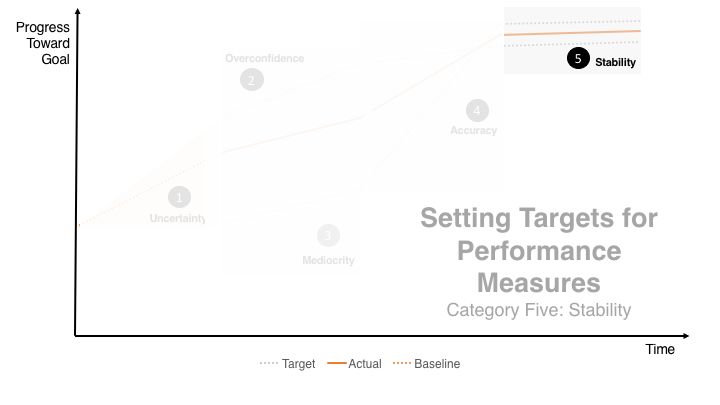Category Five: Stability
Stability occurs when performance has flatlined at an acceptable level. It occurs often with long-standing performance measures that have leveled off and show microscopic levels of improvement, if any. Targets for these measures are often 97-99% and holding. Congratulations for such a high level of achievement. It is now time to focus on a different measure.
Signs of Stability:
- There is little evidence of a continued relationship between the target and actual performance, because actual performance has stopped improving (or declining) discernibly.
- Performance has reached 97-99% and is holding, almost nothing seems to change it.
- The target is always met or sustained.
- There is very little external interest in this measure or its target. It is seen as standard business.
Figure 6

What to do with stability?
- Celebrate it. Reaching an acceptable level of performance and stabilizing is an achievement worth celebrating. It is undoubtedly the result of hard work, collaboration, and tough choices along the way. Celebrate that achievement publicly, so stakeholders know about the achievement and staff feels appreciated for their efforts.
- Learn from it. The path toward stable achievement is paved with lessons learned, so don’t forget to learn them. Put together an after action panel of stakeholders and talk about how such an optimal and stable level of performance was reached. Those conversations will have applicability across other programs.
- Identify a permanent champion. Reaching a target does not mean the work is done, and someone’s job is to keep working and ensuring performance is maintained. Make sure everyone is clear whose job that is. Ensure they understand the importance of that sustained responsibility and are ready to ensure the program maintains such an optimal level of achievement.
- Continue Monitoring (behind-the-scenes). Ensuring the program maintains a high level of achievement requires continuous monitoring by the permanent champion. If performance dips, the champion should bring everyone back to the table to refocus.
- Move on. With a permanent champion in place, it is time for senior leadership to stop tracking and setting new targets for this measure. Move on to a program or service with a more difficult record of underperformance.
What not to do with Stability?
- Do not take it for granted. High performing programs can often be ignored because no one has to spend much time thinking about them. Do not make that mistake. Take time to learn from high performing programs to make sure they can be replicated and sustained.
- Do not jeopardize it. Stability is not achieved by accident. It required specific actions, investments, and management strategies. As other performance measures and targets come into focus, be mindful about shifting resources away from the very things that led to stability in the first place.